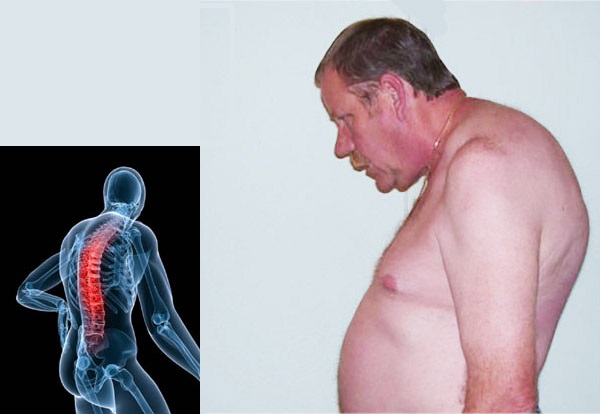Ankylosing Spondylitis, Rheumatoid spondylitis

Published: 18 Jun 2025
ICD9: 720.0 ICD10: M45.0 ICD11: FA92.0Z
Ankylosing Spondylitis (AS) and Rheumatoid Spondylitis are actually the same condition! Rheumatoid Spondylitis is an older, outdated term for what is now known as Ankylosing Spondylitis.
Therefore, Ankylosing Spondylitis (AS) is the correct and current term.
Here's a breakdown of what AS is:
![]() Definition: Ankylosing spondylitis is a type of inflammatory arthritis that primarily affects the spine. It can cause inflammation of the vertebrae (bones in the spine), which can lead to severe, chronic pain and discomfort.
Definition: Ankylosing spondylitis is a type of inflammatory arthritis that primarily affects the spine. It can cause inflammation of the vertebrae (bones in the spine), which can lead to severe, chronic pain and discomfort.
![]() Mechanism: The inflammation in AS can eventually cause the vertebrae to fuse together. This fusion makes the spine less flexible and can result in a hunched-forward posture.
Mechanism: The inflammation in AS can eventually cause the vertebrae to fuse together. This fusion makes the spine less flexible and can result in a hunched-forward posture.
![]() Symptoms: Common symptoms include:
Symptoms: Common symptoms include:![]()

![]() Pain and stiffness in the lower back and hips, especially in the morning or after periods of inactivity.
Pain and stiffness in the lower back and hips, especially in the morning or after periods of inactivity.![]()

![]() Pain that may radiate to the buttocks, thighs, or neck.
Pain that may radiate to the buttocks, thighs, or neck.![]()

![]() Fatigue.
Fatigue.![]()

![]() Eye inflammation (uveitis).
Eye inflammation (uveitis).![]()

![]() Joint pain in other areas, such as shoulders, knees, or ankles.
Joint pain in other areas, such as shoulders, knees, or ankles.![]()

![]() In severe cases, difficulty breathing due to rib cage involvement.
In severe cases, difficulty breathing due to rib cage involvement.
![]() Cause: The exact cause of AS is unknown, but it is believed to be a combination of genetic and environmental factors. Most people with AS have a specific gene called HLA-B27.
Cause: The exact cause of AS is unknown, but it is believed to be a combination of genetic and environmental factors. Most people with AS have a specific gene called HLA-B27.
![]() Diagnosis: Diagnosis typically involves:
Diagnosis: Diagnosis typically involves:![]()

![]() A physical exam to assess posture, range of motion, and reflexes.
A physical exam to assess posture, range of motion, and reflexes.![]()

![]() X-rays or MRI of the spine to look for signs of inflammation and fusion.
X-rays or MRI of the spine to look for signs of inflammation and fusion.![]()

![]() Blood tests to check for the HLA-B27 gene and markers of inflammation.
Blood tests to check for the HLA-B27 gene and markers of inflammation.
![]() Treatment: There is no cure for AS, but treatment can help manage symptoms and slow the progression of the disease. Treatment options include:
Treatment: There is no cure for AS, but treatment can help manage symptoms and slow the progression of the disease. Treatment options include:![]()

![]() Medications:
Medications:![]()

![]() NSAIDs (Nonsteroidal anti-inflammatory drugs): To relieve pain and inflammation.
NSAIDs (Nonsteroidal anti-inflammatory drugs): To relieve pain and inflammation.![]()

![]() DMARDs (Disease-modifying antirheumatic drugs): To slow the progression of the disease (e.g., sulfasalazine, methotrexate).
DMARDs (Disease-modifying antirheumatic drugs): To slow the progression of the disease (e.g., sulfasalazine, methotrexate).![]()

![]() Biologics (TNF inhibitors and IL-17 inhibitors): Powerful medications that target specific proteins involved in inflammation (e.g., etanercept, infliximab, adalimumab, secukinumab, ixekizumab).
Biologics (TNF inhibitors and IL-17 inhibitors): Powerful medications that target specific proteins involved in inflammation (e.g., etanercept, infliximab, adalimumab, secukinumab, ixekizumab).![]()

![]() Physical Therapy: To improve posture, flexibility, and strength.
Physical Therapy: To improve posture, flexibility, and strength.![]()

![]() Exercise: Regular exercise can help reduce pain and stiffness.
Exercise: Regular exercise can help reduce pain and stiffness.![]()

![]() Surgery: In rare cases, surgery may be needed to correct severe deformities or relieve pressure on nerves.
Surgery: In rare cases, surgery may be needed to correct severe deformities or relieve pressure on nerves.
In summary: Don't use the term "Rheumatoid Spondylitis." Use "Ankylosing Spondylitis." It's a chronic inflammatory condition primarily affecting the spine. If you think you might have symptoms of AS, it's crucial to see a doctor (usually a rheumatologist) for proper diagnosis and management.